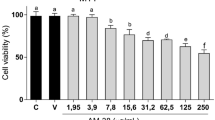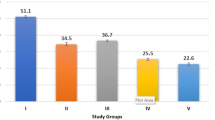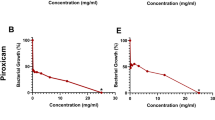Abstract
Objective
Evaluate, in vitro, the antimicrobial activity of Psidium cattleianum leaf extracts combined with calcium hydroxide against Enterococcus faecalis and Candida albicans biofilm.
Materials and methods
Dentin specimens obtained from extracted bovine incisors were infected during 14 days with E. faecalis ATCC 29212 and C. albicans ATCC 10231. The specimens were filled with calcium hydroxide pastes prepared with the following vehicles: Psidium cattleianum ethanolic, Psidium cattleianum propylene glycolic, distilled water, and saline as control. After 24 h, 3, 7, and 14 days, the canals were irrigated with sterile saline and dried. Dentin samples were collected from the canals with burs of increasing diameters. To determine the number of colony-forming units (CFU), samples were inoculated onto BHI agar supplemented with yeast extract (0.5%), at 37 °C, for 48 h, in CO2 enriched atmosphere. Comparisons among the groups for the variation factors were performed by ANOVA and Tukey’s test.
Results
Ethanolic and propylene glycolic extracts showed significantly higher antimicrobial activity against E. faecalis (p < 0.01) when compared with distilled water. The ethanolic extract exhibited in 24 h the same antibacterial activity that propylene glycolic extract and distilled water after 7 and 14 days. For C. albicans, all were effective in reducing the number of CFU at all periods.
Conclusion
The P. cattleianum ethanolic extract presented the fastest and highest antimicrobial activity against E. faecalis, significantly reducing the microbial load in 24 h. All medications were effective against C. albicans.
Clinical relevance
The antibacterial potential of P. cattleianum and its biological compatibility associated with calcium hydroxide indicate promising applications in the field of dentistry.

Similar content being viewed by others
References
Kakehashi S, Stanley HR, Fitzgerald RJ (1965) The effects of surgical exposures of dental pulps in germ-free and conventional laboratory rats. Oral Surg Oral Med Oral Pathol 20(3):340–349. https://doi.org/10.1016/0030-4220(65)90166-0
Bystrom A, Sundqvist G (1981) Bacteriologic evaluation of the efficacy of mechanical root canal instrumentation in endodontic therapy. Scand J Dent Res 89(4):321–328
Waltimo TMT, Orstavik D, Sirén EK, Haapasalo MPP (2000) In vitro yeast infection of human dentin. J Endod 26(4):207–209. https://doi.org/10.1097/00004770-200004000-00002
Safavi KE, Spangberg SW, Langeland K (1990) Root canal dentinl tubule disinfection. J Endod 16(5):207–210. https://doi.org/10.1016/S0099-2399(06)81670-5
Cogulu D, Uzel A, Oncag O, Eronat C (2008) PCR-based identification of selected pathogens associated with endodontic infections in deciduous and permanent teeth. Oral Surg Oral Med Oral Pathol Oral Radiol Endod 106(3):443–449. https://doi.org/10.1016/j.tripleo.2008.03.004
Estrela C, Sydney GB, Bammann LL, Felippe-Jr O (1995) Mechanism of the action of calcium and hydroxyl ions of calcium hydroxide on tissue and bacteria. Braz Dent J 6(2):85–90
Siqueira JF Jr, Lopes HP (1999) Mechanisms of antimicrobial activity of calcium hydroxide: a critical review. Int Endod J 32:361–369
Sjogren U, Figdor D, Spangberg L, Sundqvist G (1991) The antimicrobial effect of calcium hydroxide as a short-term intracanal dressing. Int Endod J 24(3):119–125. https://doi.org/10.1111/j.1365-2591.1991.tb00117.x
Orstavik D, Haapasalo M (1990) Disinfection by endodontic irrigants and dressings of experimentally infected dentinl tubules. Endod Dent Traumatol 6(4):142–149. https://doi.org/10.1111/j.1600-9657.1990.tb00409.x
Waltimo TMT, Orstavik D, Sirén EK, Haapasalo MPP (1999) In vitro susceptibility of Candida albicans to four disinfectants and their combinations. Int Endod J 32(6):421–429. https://doi.org/10.1046/j.1365-2591.1999.00237.x
Evans M, Davies JK, Sundqvist G, Figdor D (2002) Mechanisms involved in the resistance of Enterococcus faecalis to calcium hydroxide. Int Endod J 35(3):221–228. https://doi.org/10.1046/j.1365-2591.2002.00504.x
George S, Kishen A, Song KP (2005) The role of environmental changes on monospecies biofilm formation on root canal wall by Enterococcus faecalis. J Endod 31(12):867–872. https://doi.org/10.1097/01.don.0000164855.98346.fc
Turk BT, Ates M, Sen BH (2008) The effect of treatment of radicular dentin on colonization patterns of C. albicans. Oral Surg Oral Med Oral Pathol Oral Radiol Endod 106(3):457–462. https://doi.org/10.1016/j.tripleo.2008.05.012
Araújo A, Henriques M, Silva S (2017) Portrait of Candida species biofilm regulatory network genes. Trends Microbiol 25(1):62–75. https://doi.org/10.1016/j.tim.2016.09.004
Delgado RJR, Gasparoto TH, Sipert CR, Pinheiro CR et al (2013) Antimicrobial activity of calcium hydroxide and chlorhexidine on intratubular Candida albicans. Int J Oral Sci 5(1):32–36. https://doi.org/10.1038/ijos.2013.12
Mejía JBC (2014) Antimicrobial effects of calcium hydroxide, chlorhexidine, and propolis on enterococcus faecalis and Candida albicans. J Investig Clin Dent 5(3):194–200. https://doi.org/10.1111/jicd.12041
Paikkatt JV, Sreedharan S, Philomina B, Kannan VP, Santhakumar M, Kumar TVA (2017) Eficacy of various intracanal medicaments in human primary teeth with necrotic pulp against Candida biofillms: an in vivo study. Int J Clin Pediatr Dent 10(1):45–48. https://doi.org/10.5005/jp-journals-10005-1406
Waltimo TM, Sirén EK, Ørstavik D, Haapasalo MP (1999) Susceptibility of oral Candida species to calcium hydroxide in vitro. Int Endod J 32(2):94–98. https://doi.org/10.1046/j.1365-2591.1999.00195.x
Fouad AF, Zerella J, Barry J, Spanberg LS (2005) Molecular detection of enterococcus species in root canals of therapy-resistant endodon-tic infections. Oral Surg Oral Med Oral Pathol Oral Radiol Endod 99(1):112–118. https://doi.org/10.1016/j.tripleo.2004.06.064
Richards D, Davies JK, Figdor D (2010) Starvation survival and recovery in serum of Candida albicans compared with Enterococcus faecalis. Oral Surg Oral Med Oral Pathol Oral Radiol Endod 110(1):125–130. https://doi.org/10.1016/j.tripleo.2010.03.007
Waltimo TM, Sirén EK, Torkko HL, Olsen I, Haapasalo MP (1997) Fungi in therapy-resistant apical periodontitis. Int Endod J 30(2):96–101. https://doi.org/10.1111/j.1365-2591.1997.tb00681.x
Stuart CH, Schwartz SA, Beeson TJ, Owatz CB (2006) Enterococcus faecalis: its role in root canal treatment failure and current concepts in retreatment. J Endod 32(2):93–98. https://doi.org/10.1016/j.joen.2005.10.049
Persoon IF, Crielaard W, Ozok AR (2017) Prevalence and nature of fungi in root canal infections: a systematic review and meta-analysis. Int Endod J 50(11):1055–1066. https://doi.org/10.1111/iej.12730
Ercan E, Dalli M, Dülgergil CT (2006) In vitro assessment of the effectiveness of chlorhexidine gel and calcium hydroxide paste with chlorhexidine against Enterococcus faecalis and Candida albicans. Oral Surg Oral Med Oral Pathol Oral Radiol Endod 102:27–31
Roças IN, Siqueira JF, Santos KR (2004) Association of Enterococcus faecalis with different forms or periradicular diseases. J Endod 30(5):315–320. https://doi.org/10.1097/00004770-200405000-00004
Salineiro FCS, Bianco KG, Gaetti Jardim-Júnior E (2009) Evaluation of antimicrobial activity of plant extracts from the Brazilian savannah on Streptococcus mutans. J Appl Oral Sci; n. Esp.: 485 abstract 307
Sangalli J, Dezan E Jr, Gaetti-Jardim E Jr (2009) Antimicrobial activity of six plant extracts from the Brazilian savanna on microbial biofilms. Braz Oral Res 23(Supplement 1):294 Abstract PNe073
Brighenti FL, Luppens SBI, Delbem ACB et al (2008) Effect of Psidium cattleianum leaf extract on Streptococcus mutans viability, protein expression and acid production. Caries Res 42(2):148–154. https://doi.org/10.1159/000121439
de Menezes TEC, Delbem ACB, Brighenti FL, Okamoto AC, Gaetti-Jardim E Jr (2010) Protective efficacy of Psidium cattleianum and Myracrodruon urundeuva aqueous extracts against caries development in rats. Pharm Biol 48(3):300–305. https://doi.org/10.3109/13880200903122202
Ruviére DB, Machado AC, Novais RZ, Gaetti Jardim-Junior E, Dezan Jr E (2009) Evaluation of the tissue response to inactivated microorganisms associated with aqueous and hydroalcoholic araça (Psidium cattleianum) solutions. J Appl Oral Sci; n. Esp. 432 abstract 019
Valentim D, Bueno CRE, Marques VAS, Vasques AMV, Cury MTS, Cintra LTA, Dezan Junior E (2017) Calcium hydroxide associated with a new vehicle: Psidium cattleianum leaf extracts. Tissue response evaluation. Braz Oral Res 31:1–8
Haapasalo M, Orstavik D (1987) In vitro infection and disinfection of dentinal tubules. J Dent Res 66(8):1375–1379. https://doi.org/10.1177/00220345870660081801
Peciuliene V, Reynaud AH, Balciuniene I, Haapasalo M (2001) Isolation of yeasts and enteric bacteria in root-filled teeth with chronic apical periodontitis. Int Endod J 34(6):429–434. https://doi.org/10.1046/j.1365-2591.2001.00411.x
Pinheiro ET, Gomes BPFA, Ferraz CCR, Sousa ELR, Teixeira FB, Souza-Filho FJ (2003) Microorganisms from canals of root-filled teeth with periapical lesions. Int Endod J 36(1):1–11. https://doi.org/10.1046/j.1365-2591.2003.00603.x
Haynes K (2001) Virulence in Candida species. Trends Microbiol 9(12):591–596. https://doi.org/10.1016/S0966-842X(01)02237-5
Miranda TT, Vianna CR, Rodrigues L, Rosa CA, Corrêa A Jr (2015) Differential proteinase patterns among Candida albicans strains isolated from root canal and lingual dorsum: possible roles in periapical disease. J Endod 41(6):841–845. https://doi.org/10.1016/j.joen.2015.01.012
Foreman PC, Barnes IE (1990) A review of calcium hydroxide. Int Endod J 23(6):283–297. https://doi.org/10.1111/j.1365-2591.1990.tb00108.x
Hasselgren G, Olsson B, Cvek M (1988) Effects of calcium hydroxide and sodium hypoclorite on the dissolution of necrotic porcine muscle tissue. J Endod 14(3):125–127. https://doi.org/10.1016/S0099-2399(88)80212-7
Gomes BPFA, Montagner F, Berber VB, Zaia AA, Ferraz CCR, Almeida JFA, Souza-Filho FJ (2009) Antimicrobial action of intracanal medicaments on the external root surface. J Dent 37(1):76–81. https://doi.org/10.1016/j.jdent.2008.09.009
Basrani B, Tjarderhanne L, Santos M, Pascon E, Grad H, Lawrence HP, Friedman S (2003) Efficacy of chlorhexidine and calcium hydroxide-containing medicaments against enterococcus faecalis in vitro. Oral Med Oral Surg Oral Pathol Oral Radiol Endod 96(5):618–624. https://doi.org/10.1016/S1079-2104(03)00166-5
Siqueira JF, Rocas IN, Lopes HP, Magalhaes FAC, Uzeda M (2003) Elimination of Candida albicans infection of the radicular dentin by intracanal medications. J Endod 29(8):501–504. https://doi.org/10.1097/00004770-200308000-00003
McHugh CP, Zhang P, Michalek S, Eleazer PD (2004) pH required to kill enterococcus faecalis in vitro. J Endod 30(4):218–219. https://doi.org/10.1097/00004770-200404000-00008
Gomes BPFA, Ferraz CCR, Garrido FD et al (2002) Microbial susceptibility to calcium hydroxide pastes and their vehicles. J Endod 28(11):758–761
Haenni S, Schmidlin PR, Mueller B, Sener B, Zehnder M (2003) Chemical and antimicrobial properties of calcium hydroxide mixed with irrigating solutions. Int Endod J 36(2):100–105. https://doi.org/10.1046/j.1365-2591.2003.00629.x
Dezan-Junior E, Sangalli J, Gomes-Filho JE, Gaetti-Jardim E Jr (2010) Psidium cattleianum plus Ca(OH)2 antimicrobial efficacy against Enterococcus faecalis. IADR J Dent Res 89:15–16 Special Issue B
Massunari L, Novais RZ, Oliveira MT, Valentim D, Dezan-Junior E, Duque C (2017) Antimicrobial activity and biocompatibility of the Psidium cattleianum extracts for endodontic purposes. Braz Dent J 28(3):372–379. https://doi.org/10.1590/0103-6440201601409
Siqueira JF Jr, Rôças IN, Lopes HP, Elias CN, de Uzeda M (2002) Fungal infection of the radicular dentin. J Endod 28:770–773
Bystrom A, Claesson R, Sundqvist G (1985) The antibacterial effect of camphorated paramonochlorophenol, camphorated phenol and calcium hydroxide in the treatment of infected root canals. Endod Dent Traumatol 1(5):170–175. https://doi.org/10.1111/j.1600-9657.1985.tb00652.x
National Genetic Resources Program, United States Department of Agriculture (2005) Agricultural research service: phytochemical and ethnobotanical databases (online database). Beltsville, National Germplasm Resources Laboratory
Dixon RA, Dey PM, Lamb CJ (1983) Phytoalexins: enzymology and molecular biology. Adv Enzymol Relat Areas Mol Biol 55:1–136
Cowan MM (1999) Plant products as antimicrobial agents. Clin Microbiol Rev 12(4):564–582
Scalbert A (1991) Antimicrobial properties of tannins. Phytochemistry 30(12):3875–3883. https://doi.org/10.1016/0031-9422(91)83426-L
Mason TL, Wasserman BP (1987) Inactivation of red beet betaglucan synthase by native and oxidized phenolic compounds. Phytochemistry 26(8):2197–2202. https://doi.org/10.1016/S0031-9422(00)84683-X
Funding
This research was suported by the Conselho Nacional de Desenvolvimento Científico e Tecnológico (CNPq)—Brazil.
Author information
Authors and Affiliations
Corresponding author
Ethics declarations
Conflict of interest
The authors declare that they have no conflict of interest.
Ethical approval
This article does not contain any studies with human participants or animals performed by any of the authors.
Informed consent
For this type of study, formal consent is not required.
Rights and permissions
About this article
Cite this article
Sangalli, J., Júnior, E.G.J., Bueno, C.R.E. et al. Antimicrobial activity of Psidium cattleianum associated with calcium hydroxide against Enterococcus faecalis and Candida albicans: an in vitro study. Clin Oral Invest 22, 2273–2279 (2018). https://doi.org/10.1007/s00784-017-2326-5
Received:
Accepted:
Published:
Issue Date:
DOI: https://doi.org/10.1007/s00784-017-2326-5




